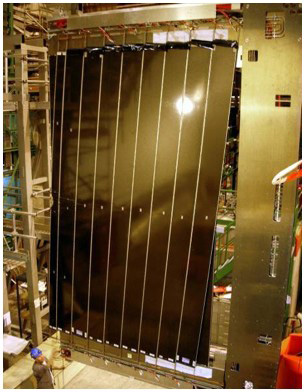High-flying aeroplanes are often only visible from the ground by the trails of water vapour they leave behind. Charged particles, like electrons and protons, also leave behind trails when passing through certain substances, enabling scientists to record their movements.
Trackers are devices specifically designed to exploit this fact. They enable the trajectory of each particle passing through the detector to be recorded, which helps scientists to link together the signals left in the other detector elements, and is absolutely crucial for reconstructing B particle decays.
LHCb’s tracking system consists of a series of four large rectangular stations, each covering an area of about 40 m². Two different detector technologies are employed. The silicon tracker, which is placed close to the beam pipe, uses silicon microstrip detectors to detect passing particles.
Charged particles collide with silicon atoms, liberating electrons and creating an electric current, which indicates the path of the original particle.

The outer tracker is situated further from the beam pipe and is made up of thousands of gas-filled straw tubes. Whenever a charged particle passes through, it ionizes the gas molecules, producing electrons. The position of the track is found by timing how long the electrons take to reach an anode wire situated in the centre of each tube.
